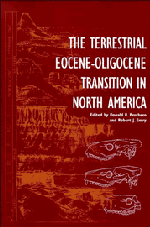Book contents
- Frontmatter
- Contents
- Contributors
- Preface
- PART I The Chronostratigraphy of the Uintan through Arikareean
- 1 Magnetic stratigraphy and biostratigraphy of the middle Eocene Uinta Formation, Uinta Basin, Utah
- 2 Biostratigraphy and magnetostratigraphy of the Bridgerian-Uintan Washakie Formation, Washakie Basin, Wyoming
- 3 Magnetic stratigraphy, sedimentology, and mammalian faunas of the early Uintan Washakie Formation, Sand Wash Basin, northwestern Colorado
- 4 Theoretical biochronology, the Bridgerian-Uintan boundary and the “Shoshonian Subage” of the Uintan
- 5 Middle Eocene mammalian faunas of San Diego County, California
- 6 Stratigraphy and paleomagnetism of the middle Eocene Friars Formation and Poway Group, southwestern San Diego County, California
- 7 Magnetostratigraphy of the upper middle Eocene Coldwater Sandstone, central Ventura County, California
- 8 Stratigraphy and paleomagnetism of the upper middle Eocene to lower Miocene (Uintan to Arikareean) Sespe Formation, Ventura County, California
- 9 Magnetostratigraphy of the Eocene-Oligocene transition in Trans-Pecos Texas
- 10 Magnetic stratigraphy of the Duchesnean part of the Galisteo Formation, New Mexico
- 11 Stratigraphy and vertebrate faunas of the Bridgerian-Duchesnean Clarno Formation, north-central Oregon
- 12 Eocene-Oligocene faunas of the Cypress Hills Formation, Saskatchewan
- 13 Magnetic stratigraphy of the White River Group in the High Plains
- 14 Magnetostratigraphy and biostratigraphy of the Eocene-Oligocene transition, southwestern Montana
- 15 The Whitneyan-Arikareean transition in the High Plains
- PART II Common Vertebrates of the White River Chronofauna
- Summary
- Index
2 - Biostratigraphy and magnetostratigraphy of the Bridgerian-Uintan Washakie Formation, Washakie Basin, Wyoming
Published online by Cambridge University Press: 06 July 2010
- Frontmatter
- Contents
- Contributors
- Preface
- PART I The Chronostratigraphy of the Uintan through Arikareean
- 1 Magnetic stratigraphy and biostratigraphy of the middle Eocene Uinta Formation, Uinta Basin, Utah
- 2 Biostratigraphy and magnetostratigraphy of the Bridgerian-Uintan Washakie Formation, Washakie Basin, Wyoming
- 3 Magnetic stratigraphy, sedimentology, and mammalian faunas of the early Uintan Washakie Formation, Sand Wash Basin, northwestern Colorado
- 4 Theoretical biochronology, the Bridgerian-Uintan boundary and the “Shoshonian Subage” of the Uintan
- 5 Middle Eocene mammalian faunas of San Diego County, California
- 6 Stratigraphy and paleomagnetism of the middle Eocene Friars Formation and Poway Group, southwestern San Diego County, California
- 7 Magnetostratigraphy of the upper middle Eocene Coldwater Sandstone, central Ventura County, California
- 8 Stratigraphy and paleomagnetism of the upper middle Eocene to lower Miocene (Uintan to Arikareean) Sespe Formation, Ventura County, California
- 9 Magnetostratigraphy of the Eocene-Oligocene transition in Trans-Pecos Texas
- 10 Magnetic stratigraphy of the Duchesnean part of the Galisteo Formation, New Mexico
- 11 Stratigraphy and vertebrate faunas of the Bridgerian-Duchesnean Clarno Formation, north-central Oregon
- 12 Eocene-Oligocene faunas of the Cypress Hills Formation, Saskatchewan
- 13 Magnetic stratigraphy of the White River Group in the High Plains
- 14 Magnetostratigraphy and biostratigraphy of the Eocene-Oligocene transition, southwestern Montana
- 15 The Whitneyan-Arikareean transition in the High Plains
- PART II Common Vertebrates of the White River Chronofauna
- Summary
- Index
Summary
ABSTRACT
We summarize and add to the biostratigraphy and magnetic polarity stratigraphy of the Washakie Formation, Washakie Basin, Wyoming. Previously the Washakie Formation (divided into the lower Kinney Rim Member and the upper Adobe Town Member) was thought to contain rocks of early Bridgerian through late Uintan age. Continuing collection efforts in the Washakie Basin by the Field Museum of Natural History (FMNH) allow us to revise the biochronologically determined age of the Washakie Formation to late Bridgerian through early Uintan age.
A late Bridgerian age for the poorly fossiliferous Kinney Rim Member of the Washakie Formation is indicated by the presence of Hyrachyus eximius (a taxon with a late Bridgerian first occurrence elsewhere). In addition, the following taxa are also known from the Kinney Rim Member: Peratherium cf. P. knighti, cf. Apatemys bellus, Hyopsodus sp., Orohippus sp., Mesatirhinus sp., Helaletes nanus, and Hyrachyus modestus (all known from the Bridgerian elsewhere, but none restricted to the late Bridgerian, except possibly Mesatirhinus). In addition, taxa restricted to the early Bridgerian of the Bridger Basin (e.g., Smilodectes) have not been recovered from the Washakie Formation, except for a possible new species of tillodont from the Kinney Rim Member.
An early Uintan age for the upper unit of the Adobe Town Member, the uppermost unit in the Washakie Formation, is indicated by the occurrence of Pareumys grangeri (restricted to the early Uintan elsewhere). In addition, Paramys compressidens and Epihippus gracilis (both known from the Uintan elsewhere, but neither restricted to the early Uintan) are also known from the upper unit.
- Type
- Chapter
- Information
- Publisher: Cambridge University PressPrint publication year: 1996
- 11
- Cited by



